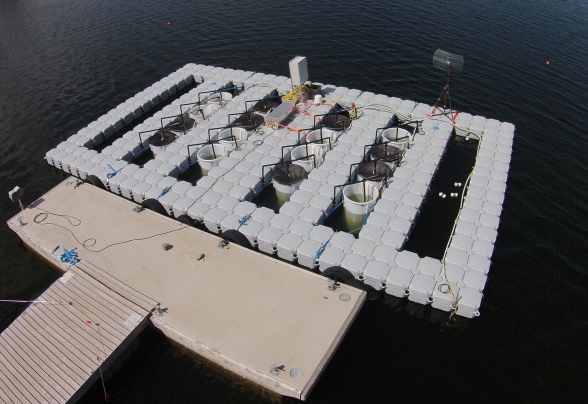SITES AquaNET
Researchers in Sweden used Apogee SQ-500 full-spectrum quantum sensors to create a new mesocosm infrastructure—SITES AquaNET—located in five lakes connected to field stations in Sweden. The research was published in the journal of Limnology and Oceanography Methods in May 2021.
Each of the five lakes vary in environmental conditions, which allows achieving general conclusions on ecological phenomena; particularly how local differences between variables (e.g., temperature, elevation, nutrients, etc.) affect the outcomes of experimental manipulations. An Apogee SQ-500 full-spectrum quantum sensor is mounted on a stainless steel plate to measure photosynthetically active radiation (PAR). The sensors in the lake are placed at two different depths in order to calculate the diffuse attenuation coefficient of light in the lake. The SITES AquaNET mesocosm program was designed to allow testing of general hypothesis in experimental aquatic research. Swedish researchers now have a fully functioning mesocosm infrastructure that offers the opportunity for scientists to perform coordinated and collaborative experiments.
Read more about the research below.


ABSTRACT: For aquatic scientists mesocosm experiments are important tools for hypothesis testing as they offer a compromise between experimental control and realism. Here we present a new mesocosm infrastructure—SITES AquaNET—located in five lakes connected to field stations in Sweden that cover a ~760 km latitudinal gradient. SITES AquaNet overcomes major hindrances in aquatic experimental research through: (i) openness to the scientific community, (ii) the potential to implement coordinated experiments across sites and time, and (iii) high-frequency measurements (temperature, photosynthetic photon flux density, turbidity and dissolved oxygen, chlorophyll a and phycocyanin concentrations) with an autonomous sensor system. Moreover, the infrastructure provides operational guidance and sensor expertise from technical staff, and connections to a multi-layered monitoring programme (“SITES Water”) for each lake. This enables ecological observations from whole lake ecosystems to be compared with experimental studies aiming at disentangling major drivers and mechanisms underlying observed changes. Here we describe the technical properties of the infrastructure along with possibilities for experimental manipulations to tackle pressing issues in aquatic ecology and global change science. As a proof of concept, we also present a first mesocosm experiment across all five field sites with a cross-factorial design to evaluate responses of the sensor measurements to press/bottom-up (constant light reduction) and pulse/top-down (temporary fish predation) disturbances. This demonstrates the suitability of the infrastructure and autonomous sensor system to host modularized experiments and exemplifies the power and advantages of the approach to integrate a network of mesocosm facilities with manageable costs across large geographic areas.
Visit the SITES AquaNET website to learn more >

Figure 1. Sensor installations within the mesocosms. (A) View of an experimental unit (mesocosm) from above. The cross black tube is used to sustain the three sensors inside of the mesocosm, with the fluorometer (Trilux) and optode (Aanderaa) facing north and the PPFD sensor facing south. (B) View from the west side showing the depth at which the sensors are deployed. In addition, the black tubing (which is possible to separate from the jetfloat) allows for the sensors to be pulled out of the mesocosms for maintenance and cleaning procedures.
